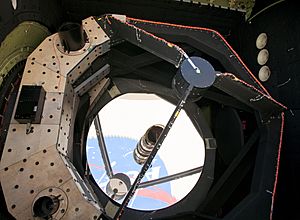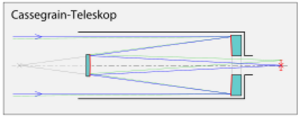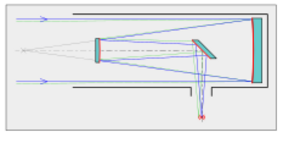Reflecting telescope facts for kids
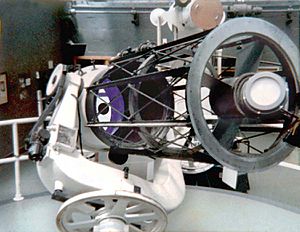
A reflecting telescope (also called a reflector) is a special kind of telescope. It uses one or more curved mirrors to gather and focus light, creating an image. The reflecting telescope was invented in the 1600s by Isaac Newton. He created it as a better option to the refracting telescope, which had problems with blurry colors (called chromatic aberration) at that time.
Even though reflecting telescopes can have other small image problems, their design allows for very large mirrors. This is why almost all big telescopes used for studying astronomy today are reflectors. Many different types of reflectors exist. Some use extra parts to make the image clearer or to put the image in a good spot for viewing. Since these telescopes use mirrors, they are sometimes called catoptric telescopes.
From Newton's time until the 1800s, telescope mirrors were often made of metal. Newton's first designs used metal mirrors. The largest telescope of the 1800s, the Leviathan of Parsonstown, had a 6-foot wide metal mirror. In the 1800s, a new method became popular: using glass coated with a very thin layer of silver. Metal mirrors only reflected about two-thirds of the light and would get dull over time. After many cleanings, the mirror could lose its perfect shape. Glass mirrors with silver coatings were a big improvement.
Reflecting telescopes became very popular for astronomy. Famous telescopes like the Hubble Space Telescope use this design. Many popular telescopes for amateur astronomers also use it. The idea of reflection is also used in other areas, like X-ray telescopes, to create images.
Contents
How Reflecting Telescopes Started
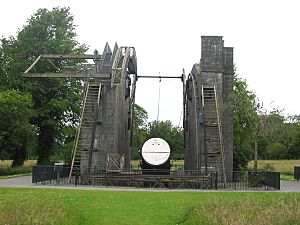
People knew that curved mirrors could act like lenses as far back as the 1000s. After the refracting telescope was invented, scientists like Galileo thought about building a telescope using a mirror. There were reports of early attempts, but they didn't make clear images.
The idea of using parabolic mirrors was exciting because they could avoid blurry colors. James Gregory published a new design in 1663. Ten years later, Robert Hooke built this type of telescope, which became known as the Gregorian telescope.
However, Isaac Newton built his own reflecting telescope in 1668. This is usually seen as the first successful reflecting telescope. It used a round metal primary mirror and a small flat mirror. This design is now called the Newtonian telescope.
Even with their good ideas, reflecting telescopes took over 100 years to become popular. This was because they were hard to build, and the metal mirrors of the time didn't work very well. Over time, many improvements were made. These included making perfect parabolic mirrors, using silver-coated glass mirrors (in the 1800s), and using long-lasting aluminum coatings (in the 1900s). Later, segmented mirrors allowed for even larger telescopes.
In the mid-1900s, new types like catadioptric telescopes appeared. These use both a mirror and a lens to get wide, clear images. Today, reflecting telescopes are used everywhere, including in space telescopes and many spacecraft cameras.
How Reflecting Telescopes Work

The main part of a reflecting telescope is its curved primary mirror. This mirror collects light and creates an image at a special spot called the focal plane. The distance from the mirror to this spot is the focal length. You can place a camera or a digital sensor here to record the image. Sometimes, a secondary mirror is added to change the light path or send the light to an eyepiece for you to look through.
Most modern telescope mirrors are made from a solid piece of glass. The front surface is shaped like a sphere or a parabola. Then, a very thin layer of aluminum is put onto the mirror in a vacuum. This makes it a very shiny first surface mirror.
Some telescopes use mirrors made in a different way. Molten glass is spun around until its surface becomes paraboloid. It keeps spinning as it cools and hardens. This method helps create a mirror shape that needs less grinding to be perfect.
Image Quality and Challenges
Reflecting telescopes, like all optical tools, don't make "perfect" images. They need to see objects that are very far away, use different colors of light, and let us view the image. This means there are always some trade-offs in their design.
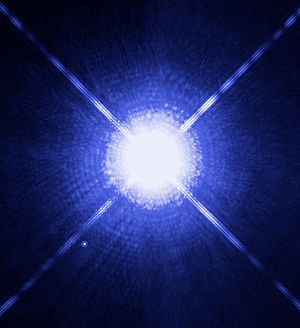
Because the main mirror focuses light in front of itself, most reflecting telescopes have a secondary mirror or a camera in that spot. This part blocks some of the incoming light. This not only reduces the light collected but also causes a slight loss of image sharpness. It can also create "spikes" around bright stars, which are caused by the supports holding the secondary mirror.
Mirrors avoid the problem of chromatic aberration (blurry colors). However, they can have other types of image problems. A simple spherical mirror can't focus all light to one point. Light hitting the edge of the mirror focuses differently than light hitting the center. This problem is called spherical aberration. To fix this, most reflecting telescopes use parabolic shaped mirrors. These mirrors can focus all light to a single point.
Parabolic mirrors work well for objects in the center of the image. But for objects towards the edge of the view, they can have other issues:
- Coma – This makes stars look like small "comets" or smudges, especially near the edges of the image.
- Field curvature – The best image might be on a curved surface, which doesn't match flat cameras.
- Astigmatism – This makes point-like objects look stretched or elliptical, especially off-center.
- Distortion – This changes the shape of objects but doesn't make them blurry. It can sometimes be fixed with computer programs.
Some reflecting telescope designs use specially shaped mirrors or correcting lenses to fix these problems.
Why Reflectors Are Used in Research

Almost all large telescopes used for serious astronomy research are reflectors. Here are a few reasons why:
- Wider Light Range: Reflectors can see a wider range of light colors. Lenses in refractor telescopes can absorb certain light colors.
- Easier to Make: For a mirror, only one surface needs to be perfectly smooth. For a lens, the entire piece of glass must be perfect inside.
- No Color Blurring: Mirrors don't cause chromatic aberration, which is a big problem for lenses. Making lenses that fix this problem is very expensive, especially for large ones. Mirrors are much cheaper to make for their size.
- Support for Large Sizes: Lenses can only be held by their edges. A very large lens would sag in the middle due to gravity, making the image blurry. The biggest practical lens is about 1 meter (3 feet) across. Mirrors, however, can be supported from their entire back side. This allows for much larger mirrors. The biggest reflecting telescopes today are more than 10 meters (33 feet) wide!
Types of Reflecting Telescopes
Gregorian Telescope
The Gregorian telescope was described by James Gregory in 1663. It uses a curved secondary mirror that sends the image back through a hole in the main mirror. This design creates an upright image, which is good for looking at things on Earth. Some small spotting scopes still use this design. Large modern telescopes like the Giant Magellan Telescope also use a Gregorian setup.
Newtonian Telescope
The Newtonian telescope was the first successful reflecting telescope. Isaac Newton finished it in 1668. It usually has a parabolic main mirror. A flat secondary mirror reflects the light to the side of the telescope tube, where you can view the image. This is one of the simplest and cheapest telescope designs for its size. It's very popular for people who build their own telescopes.
Cassegrain Design and Its Variations
The Cassegrain telescope design was first published in 1672. It has a parabolic main mirror and a hyperbolic secondary mirror. The secondary mirror reflects the light back through a hole in the main mirror. This design makes a telescope with a long focal length (meaning it can magnify a lot) but a short, compact tube.
Ritchey–Chrétien
The Ritchey–Chrétien telescope was invented in the early 1900s. It's a special Cassegrain design that uses two hyperbolic mirrors. This design is great for wide-field photography because it avoids coma and spherical aberration, making images very clear across the whole view. Almost every professional reflecting telescope in the world uses the Ritchey–Chrétien design.
Dall–Kirkham
The Dall–Kirkham Cassegrain telescope was created in 1928. It uses an elliptical main mirror and a spherical secondary mirror. This design is easier to make than other Cassegrain types. However, it doesn't correct for coma as well. It's often used for telescopes that are not "fast" (meaning they have a longer focal ratio).
Where the Image is Viewed
Prime Focus
In a prime focus design, there are no extra mirrors. The image is viewed directly at the focal point of the primary mirror. A camera or electronic sensor is placed here. In the past, observers would sit inside a special cage in very large telescopes to view the image. Today, digital cameras allow scientists to control the telescope from far away. The space at prime focus is limited because you don't want to block the incoming light.
Radio telescopes often use a prime focus design. Instead of a mirror, they have a metal surface to reflect radio waves, and an antenna acts as the observer.
Cassegrain Focus
For telescopes built with the Cassegrain design, the image is formed behind the main mirror. An observer can look through the back of the telescope, or a camera can be attached there. Cassegrain focus is common for amateur telescopes and smaller research telescopes. However, for very large telescopes with heavy instruments, the instrument must move with the telescope. This means the support structure needs to be very strong.
Nasmyth and Coudé Focus
Nasmyth
The Nasmyth design is like the Cassegrain, but the light doesn't go through a hole in the main mirror. Instead, a third mirror reflects the light to the side of the telescope. This allows for heavy instruments to be mounted there. This is a very common design for large research telescopes.
Coudé
Adding more mirrors to a Nasmyth-style telescope can send the light to a fixed point that doesn't move when the telescope moves. This is called a coudé focus (from the French word for elbow). The coudé focus gives a narrower view but is used for very heavy instruments that need to stay still. These instruments are often built as a permanent part of the observatory building.
Fiber-fed Spectrographs
For instruments that need to be very stable, or are very large, it's better to keep them on a solid structure instead of moving them with the telescope. For studying the light from specific objects like stars, optical fibers can collect light from the telescope. These fibers then carry the light to the instrument, which can be placed far away. Examples include planet-hunting instruments like HARPS.
See also
 In Spanish: Telescopio reflector para niños
In Spanish: Telescopio reflector para niños


